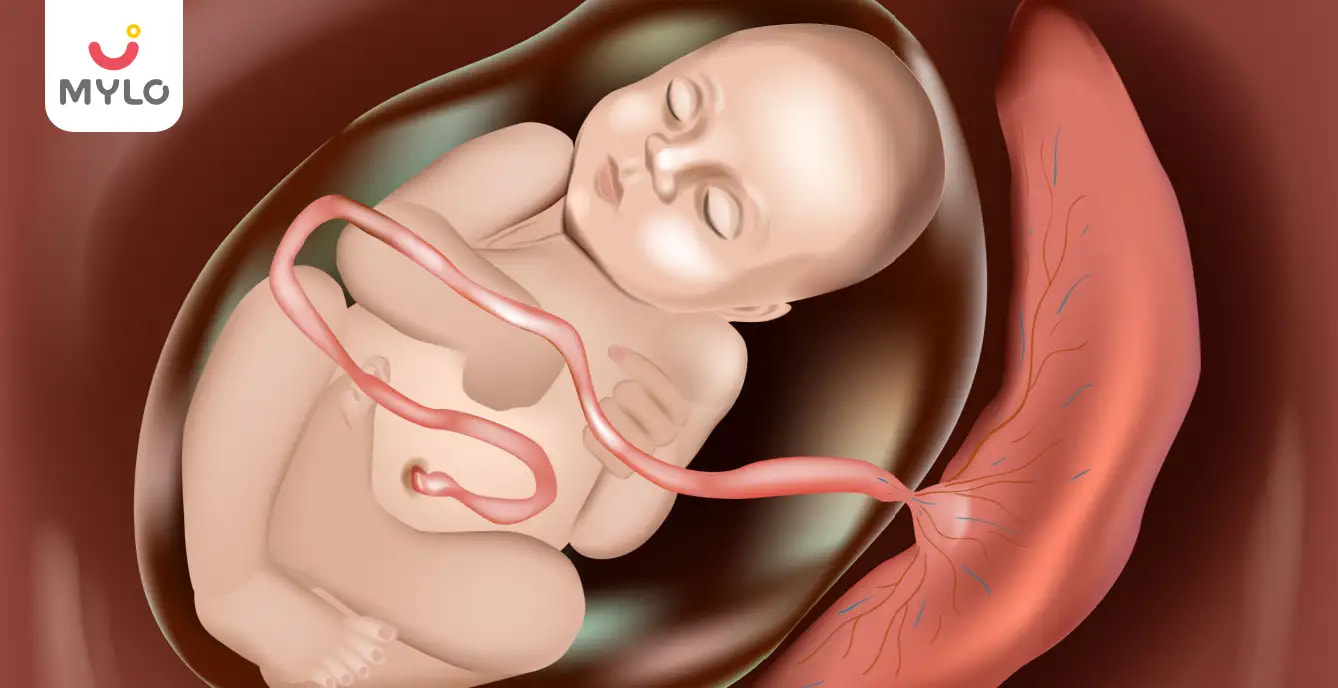Home

Placental Abruption

A Comprehensive Guide to Understanding Placenta Accreta
In this Article

Placental Abruption
A Comprehensive Guide to Understanding Placenta Accreta
Updated on 3 November 2023
Placenta accreta is a serious condition that can have serious implications for both the mother and the baby during pregnancy. It occurs when the placenta grows too deeply into the uterine wall, leading to a variety of complications.
In this comprehensive guide, we will discuss the causes, symptoms, diagnosis, and treatment of this condition. We will also look at ways to prevent it and possible complications that can arise.
What is Placenta Accreta?
The placenta is a thick, spongy organ that provides the baby with oxygen and nutrients through the umbilical cord. It also helps to protect the baby from infection. In a normal pregnancy, the placenta attaches to the wall of the uterus and stays in place throughout the pregnancy. In placenta accreta, the placenta attaches too deeply and can even penetrate into the underlying muscle layer.
What are the different placenta accreta types?
The condition is classified into three types according to the severity.
1. Placenta accreta
Placenta accreta is the most common type and occurs when the placenta attaches to the uterine wall but does not penetrate the underlying muscle layer.
2. Placenta increta
Placenta increta occurs when the placenta penetrates the muscle layer but does not penetrate the uterine wall.
3. Placenta percreta
The most serious type of placenta accreta is placenta percreta, which occurs when the placenta penetrates through the uterine wall and into other organs, such as the bladder or intestines.
You may also like: Incompetent cervix: Causes, Symptoms, & Treatment
Causes of Placenta Accreta
The exact cause of placenta accreta is not known but there are certain risk factors that can increase the chances of developing the condition. These include having a
-
History of previous C-section deliveries
-
Previous uterine surgery
-
Placenta previa, or low-lying placenta
-
Women with multiple pregnancies (twins, triplets, etc.)
The risk of developing placenta accreta increases with each additional C-section delivery. This is because the scarring caused by the C-section can make it more difficult for the placenta to attach normally to the uterine wall.
Symptoms of Placenta Accreta
In most cases, placenta accreta does not cause any symptoms. However, some women may experience bleeding during the second or third trimester of the pregnancy. This bleeding can be light or heavy, and it can occur on its own or in combination with other symptoms such as abdominal pain or cramping.
In some cases, placenta accreta can cause preterm labor or delivery. This is because the placenta may be blocking the cervix and preventing the baby from safely passing through. Women who experience preterm labor or delivery should seek immediate medical attention.
Diagnostic Testing for Placenta Accreta
If the doctor suspects placenta accreta, they will order diagnostic tests to confirm the diagnosis. The most common test is an ultrasound. This can provide images of the placenta and other organs in the uterus, which can help the doctor to determine if the placenta is attached too deeply.
Other tests, such as MRI or CT scans, may also be used to get a more detailed look at the uterus and placenta. Blood tests may also be ordered to check for signs of infection or other complications.
1. Placenta Accreta Ultrasound
A placenta accreta ultrasound is a special type of ultrasound that can help to diagnose the condition. The ultrasound uses sound waves to create images of the placenta and other organs in the uterus. The images can show if the placenta is attached too deeply.
The ultrasound can also show if the placenta is blocking the cervix or if there are any tears in the uterus that could be causing bleeding. The ultrasound can also show if there are any other complications, such as a low-lying placenta or a placenta previa.
2. Treatments for Placenta Accreta
Once placenta accreta is diagnosed, the doctor will recommend treatments to reduce the risk of complications. The most common treatment is a cesarean section delivery. This is because the placenta can be more easily removed during a c-section than during a vaginal delivery.
In some cases, the doctor may recommend a hysterectomy. This is a procedure to remove the uterus and is usually recommended if there is a risk of the placenta growing into other organs or if there are other complications.
3. Preventing Placenta Accreta
There is no sure way to prevent placenta accreta, but there are certain steps you can take to reduce your risk. These include not smoking during pregnancy and getting regular check-ups from your doctor.
If you have had a previous C-section delivery, your doctor may also recommend that you have a procedure called a cerclage. This is a procedure to stitch the cervix closed and can help to reduce the risk of preterm labor or delivery.
4. Complications of Placenta Accreta
Placenta accreta can cause a number of complications, both during and after pregnancy. These include heavy bleeding during and after delivery, infection, and the need for a hysterectomy. Placenta accreta can also cause problems with the baby, such as preterm birth and low birthweight.
In some cases, placenta accreta can cause life-threatening complications. These include hemorrhage, which is when the placenta detaches from the uterus and causes heavy bleeding. This can be fatal if not treated quickly.
Conclusion
Placenta accreta is a serious condition that can have serious implications for both the mother and the baby during pregnancy. If you think you may be at risk for placenta accreta, it is important to speak to your doctor. It is also important to follow your doctor’s advice and never skip prenatal visits.
References
1. Goh WA, Zalud I.(2016). Placenta accreta: diagnosis, management and the molecular biology of the morbidly adherent placenta. J Matern Fetal Neonatal Med.
2. Jauniaux E, Collins S, Burton GJ.(2018). Placenta accreta spectrum: pathophysiology and evidence-based anatomy for prenatal ultrasound imaging. Am J Obstet Gynecol.



Written by
Anupama Chadha
Anupama Chadha, born and raised in Delhi is a content writer who has written extensively for industries such as HR, Healthcare, Finance, Retail and Tech.
Read MoreGet baby's diet chart, and growth tips

Related Articles
Related Questions
Influenza and boostrix injection kisiko laga hai kya 8 month pregnancy me and q lagta hai ye plz reply me

Hai.... My last period was in feb 24. I tested in 40 th day morning 3:30 .. That is faint line .. I conculed mylo thz app also.... And I asked tha dr wait for 3 to 5 days ... Im also waiting ... Then I test today 4:15 test is sooooo faint ... And I feel in ma body no pregnancy symptoms. What can I do .

Baby kicks KB Marta hai Plz tell mi

PCOD kya hota hai

How to detect pcos

Related Topics
RECENTLY PUBLISHED ARTICLES
our most recent articles

Diet & Nutrition
গর্ভাবস্থায় আলুবোখরা: উপকারিতা ও ঝুঁকি | Prunes During Pregnancy: Benefits & Risks in Bengali

Diet & Nutrition
গর্ভাবস্থায় হিং | ঝুঁকি, সুবিধা এবং অন্যান্য চিকিৎসা | Hing During Pregnancy | Risks, Benefits & Other Treatments in Bengali

Women Specific Issues
স্তনের উপর সাদা দাগ: লক্ষণ, কারণ এবং চিকিৎসা | White Spots on Nipple: Causes, Symptoms, and Treatments in Bengali

Diet & Nutrition
গর্ভাবস্থায় পোহা: উপকারিতা, ধরণ এবং রেসিপি | Poha During Pregnancy: Benefits, Types & Recipes in Bengali

Diet & Nutrition
গর্ভাবস্থায় মাছ: উপকারিতা এবং ঝুঁকি | Fish In Pregnancy: Benefits and Risks in Bengali

Diet & Nutrition
গর্ভাবস্থায় রেড ওয়াইন: পার্শ্ব প্রতিক্রিয়া এবং নির্দেশিকা | Red Wine During Pregnancy: Side Effects & Guidelines in Bengali
- ইনার থাই চ্যাফিং: কারণ, উপসর্গ এবং চিকিৎসা | Inner Thigh Chafing: Causes, Symptoms & Treatment in Bengali
- গর্ভাবস্থায় ব্রাউন রাইস: উপকারিতা ও সতর্কতা | Brown Rice During Pregnancy: Benefits & Precautions in Bengali
- Velamentous Cord Insertion - Precautions, Results & Safety
- Unlock the Secret to Flawless Skin: 7 Must-Have Qualities in a Face Serum
- Unlock the Secret to Radiant Skin: How Vitamin C Serum Can Transform Your Complexion
- Gender No Bar: 10 Reasons Why Everyone Needs a Body Lotion
- Unlock the Secret to Radiant Skin How to Choose the Perfect Body Lotion for Your Skin Type
- Top 10 Reasons to Apply a Body Lotion After Every Bath
- Communication in Toddlers: Milestones & Activities
- How to Improve Vocabulary for Toddlers?
- Vulvovaginitis in Toddlers Causes, Symptoms and Treatment
- A Comprehensive Guide to Understanding Cerebral Palsy in Children
- Bitter Taste in Mouth During Pregnancy: Understanding the Causes and Remedies
- Subchorionic Hematoma: Causes, Symptoms and Treatments


AWARDS AND RECOGNITION

Mylo wins Forbes D2C Disruptor award

Mylo wins The Economic Times Promising Brands 2022
AS SEEN IN
















- Mylo Care: Effective and science-backed personal care and wellness solutions for a joyful you.
- Mylo Baby: Science-backed, gentle and effective personal care & hygiene range for your little one.
- Mylo Community: Trusted and empathetic community of 10mn+ parents and experts.
Product Categories
baby carrier | baby soap | baby wipes | stretch marks cream | baby cream | baby shampoo | baby massage oil | baby hair oil | stretch marks oil | baby body wash | baby powder | baby lotion | diaper rash cream | newborn diapers | teether | baby kajal | baby diapers | cloth diapers |








